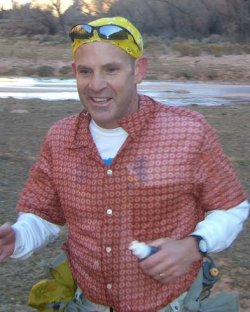The lost trailrunner did a few things right that helped him survive his ordeal. Among them, remember to always tell someone where you're going and also stay put once you realize you're lost and the sun goes down.
Trail runner rescued during stormy night near Mt. Tam
Guy Stark, 50, of Concord, had become lost and disoriented while running on Cataract Trail near Alpine Dam in the Marin Municipal Water District watershed, said Michael St. John, the search and rescue unit leader.
On Sunday, Stark had nothing but thanks for his rescuers.
"I was really happy to hear a human voice," he said. "I was amazed. I had given up hope. I don't know if I could have survived the night."

Four MMWD rangers and 34 search-and-rescue members hunted for Stark after his family reported him missing at 9 p.m. A command post was set up at Sky Oaks Ranger Station on the north side of Mount Tamalpais. Rescuers with all-terrain vehicles, a boat team and nine trail assignment teams combed the area as temperatures dipped into the low 40s.
At 11:15 p.m., Stark was found on the Helen Markt Trail on the southeast side of Alpine Lake. St. John said he was hypothermic to the point of uncontrolled shivering and was "very much in need of rescue." He was able to walk out with the assistance of the team.
"He was probably only a quarter or half a mile from his car as the crow flies," St. John said.
St. John said Stark did some smart things, such as letting his family know where he was going and hunkering down on a trail after it became dark rather than wandering. However, he left his hooded sweatshirt, cell phone and a hand warmer in his car, thinking he wouldn't need them.
He was wearing running shorts and a lightweight running shirt and had no food or water. He told rescuers that he had never before run in Marin County.
Stark had parked his car at the Cataract Creek Trailhead and started his run at about 2 p.m. He got lost - blaming his sketchy map and sub-par signage - as daylight faded and decided to stay put because of near-zero visibility.
Stark told rescuers that a shelter he'd built next to the trail worked well during the first splash of rain but not so later on. Along with the cloudbursts, thunder and lightning, Stark said he was spooked by thoughts of unwanted visitors.
"At first I was thinking about mountain lions, so I got a big stick," he said. "Then I convinced myself that the cats wouldn't be out in the rain looking for food. Plus it's hard for them to smell anything in the rain, so I started calming myself down."
A few minutes after an intense shower, he heard voices. It was search-and-rescue team leader John Channell with teens Chris Ottoboni and Ben Cook.
"I didn't think anybody was coming out because it was treacherous and rocky and slippery," Stark said. "When I first heard them, I thought they were partiers or campers because I was sure that nobody would risk their own lives to come out here looking for me. They deserve a lot of credit."











